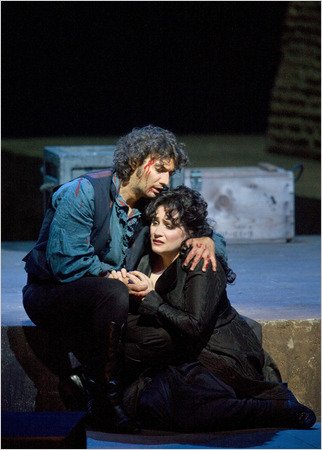|
|
|
|
|
|
|
| New York
Times, April 15, 2010 |
| By ANTHONY TOMMASINI |
| |
| Tosca, Metropolitan Opera, 14. April 2010 |
| |
Boos Become Bravos at the Met
|
 What a difference a cast can make. What a difference a cast can make.
Luc Bondy’s new production of Puccini’s
“Tosca,” which opened the Metropolitan Opera’s season
in September, returned on Wednesday night. Yes, that production, the
one with the convoluted staging that elicited vociferous boos for the
creative team when it was introduced; where the lecherous Scarpia
straddles a statue of the Blessed Virgin and consorts with tawdry
prostitutes; where, after stabbing Scarpia, Tosca muses on a couch in
his rooms at the palazzo instead of enacting the ritual of expiation
with the candles and the crucifix that Puccini devised.
Yet
Wednesday’s “Tosca” was one of the most exciting
performances of the Met season to date, thanks to three exceptional
singers, all performing their roles for the first time at the Met. Patricia
Racette, an inexplicably underrated soprano, brought a richly
expressive voice and raw emotion to her wrenching portrayal of Tosca. Jonas
Kaufmann, currently the hottest tenor in opera, was an impetuous and
vocally smoldering Mario Cavaradossi, singing with vulnerable
tenderness one moment and burnished power the next. And the bass-baritone Bryn Terfel commandeered the stage with his vocally chilling and shockingly lusty Scarpia.
The conductor Fabio Luisi, replacing James Levine, who has ongoing back
problems, drew a taut, surging performance from the orchestra, chorus
and cast — a wonder, since in the typical ways of repertory opera
houses this “Tosca” was thrown together at the last minute.
Wednesday night was the first time Mr. Luisi, the orchestra and all
three of his principals were together. After Mr. Luisi agreed to cover
for Mr. Levine, he flew into New York for one day last week to work
with the cast in a rehearsal studio. Mr. Kaufmann, nursing a bad cold,
was absent that day.
Despite
the lack of rehearsal this “Tosca” was riveting. Mr.
Kaufmann, Ms. Racette and Mr. Terfel are gifted, compelling and
intuitive actors. Their interplay — the romantic banter between
Tosca and Cavaradossi, the dangerous dance of wits between Scarpia and
Tosca — was so nuanced you would have thought the singers had
been rehearsing for weeks.
Karita Mattila, who sang Tosca when the production was introduced, was
to have returned, but she withdrew because of illness. Tosca is a
recent addition to Ms. Racette’s repertory.
She does not have a glamorous voice. Her sound can have a grainy
texture, and her sustained tones can be tremulous. Still, this role
suits her beautifully. She sang with uncommon richness, expressivity
and honesty. In the soaring phrases of “Vissi d’arte”
she captured both the dignity and despair of the character: a great
diva, yet a devout woman and fiercely jealous lover.
Mr.
Kaufmann received frenzied bravos from the audience. His russet-colored
voice has body and charisma. You could sense amazement throughout the
house at his thrilling top notes during Cavaradossi’s defiant
cries of “Vittoria!” Yet his plaintive pianissimo phrases
were equally impressive. That the youthful, curly-haired Mr. Kaufmann
is also heartthrob-handsome did not hurt.
Mr. Bondy’s production still seems drab, confused and full of
gratuitous strokes geared to rattle “Tosca” devotees. But
with Mr. Bondy not on the scene this cast made some crucial
alterations. During the “Te Deum” Mr. Terfel’s
Scarpia exuded lust and power as he fantasized about conquering Tosca.
But he stopped short of the bump-and-grind routine with the Madonna.
Even the idea of surrounding Scarpia briefly with three prostitutes in
his chambers made somewhat more sense with this Scarpia, since the
towering, robust Mr. Terfel so easily conveys bawdy physicality.
There are still no candles and crucifix. But Ms. Racette was better
than Ms. Mattila at executing Mr. Bondy’s idea that for a few
minutes Tosca, with Scarpia’s body nearby, is too stunned to do
anything other than ponder her choices.
The individual performances were so strong I hardly noticed the
elements of the production that prompted so much earlier controversy. There are seven more performances of “Tosca” this season but only three more chances to catch this outstanding cast.
|
|
|
|
|
|
|
|
|
|
|
|
|
|
|
|
|
|
|
|